- corrugated cardboard or a cardboard box
- scissors
- roller
- blockprint or tempera paint*
- colored or white sheets
dinsdag 12 maart 2024
Pretty tulip prints
zondag 14 augustus 2022
Landscape like Ton Schulten
You need:
- drawing sheet
- tempera paint in primary colors, black and white
- ruler
- pencil
- brushes
- Schulten's use of colors
- horizon line
- the 'curtains' on the sides - the picture is darker there than in the middle
- simple shapes
- divided in rectangles
woensdag 27 januari 2016
Valentine - like Robert Indiana
You need:
- drawing sheet 20 by 20 cm
- water colour paint
- brushes
- fine black marker
donderdag 22 november 2012
Typical Dutch design (group work)
- white drawing sheet A6 size (postcard)
- pencil
- markers in red, blue and silver
- coloured cardboard
- scissors and glue
Let students draw examples of cups and mugs on the digital board: narrow, wide, high, low, with belly, straight, angled, with or without foot, different ears etc.
The goal is to design cup and mugs with a Dutch design. Colour with marker and only use red and blue. Cut and paste all cups stacked on a sheet of coloured cardboard. Outline the stack with silver.
donderdag 10 mei 2012
Art cows
You need:
- 3 sheets of drawing paper 15 by 15 cm
- colour pencils
- coloured paper for background
- glue
Paste those three works on a strip of coloured construction paper.
maandag 26 september 2011
Dutch canal houses groupwork
- white drawing sheets
- tempera paint
- brushes
- pencil
- glue plakkaatverf
Before starting to paint, we talked about the Dutch Golden Age, a period roughly spanning the 17th century, in which Dutch trade, science and art were among the most acclaimed in the world. In this century many of the typical canal houses were built, in that age used as store houses. We looked at pictures of canal houses, discussed the different kinds of gables (neck gable, trep gable, bell gable) and details of the houses (windows, year it was built, stairs).
Every students gets a sheet of paper and has to draw a line on 8 cm of the bottom - this is for the canal. On the left side of the sheet there must remain a white strip of 2 cm (to paste all paintings together).
Every student draws his own canal house. Stop drawing after 5 minutes, to avoid drawint to many details. Paint the house with tempera paint. Mix colours, or for even better results: take two colours of paint on your brush and mix a little while painting.
Paste all paintings together to make a long street. Paint the canal. You might even add the words 'Groeten uit Holland'!
zaterdag 27 november 2010
Dutch December skyline
You need:
- black construction paper 20 by 20 cm
- chalk pastel
- coloured pencils
- white sheet A4 size for stencil
donderdag 25 november 2010
I love Holland
Made by students of grade 6
You need:
- two pieces of linoleum of 12 by 12 cm
- white drawing paper
- lino knives
- block printing ink in red and blue
- flat piece of glass
- linoleum roller
- lino press
- cardboard in red and blue
- scissors
- glue
2 pieces of linoleum, 2 colours, 8 prints
Finally use one or more of those prints to make a two colour print. This has to be done by inking piece 1 red and printing it on a blue print of piece 2. See picture below. Let students choose their best prints and let them decide how many prints they want to use for their final artwork. Cut the prints with 1 cm white aound them. Make a composition on blue or red cardboard and paste the prints with 1 cm between them.Final composition I love Holland, by Malou, grade 6
dinsdag 12 oktober 2010
Reflected canal houses
You need:
- white drawing sheet A4 size
- white crayons
- watercolour paint
- brushes
- jar with water
Draw a line at 12 cm from the bottom of the sheet. Draw some low canal house with a white crayon. Draw windows, treps and doors in them. Paint every house with a different colour of watercolour paint. The crayon will resist the paint and become visible. Paint a simplified reflection of the house under the line. Paint water and air.
woensdag 15 september 2010
Birds like Corneille (2nd lesson)
- white drawing paper A4 size
- oil pastels
- coloured ink
- brushes
- jar with water
- coloured paper for background
- glue or stapler
See my former lesson for information about the artist.
Show examples of Corneille's work. What subjects do you see in his paintings? What can you tell about his style: bright colours, thick black outlines, few details, painted as if it was made by a child, an image that sometimes is not complete (missing parts at the edges).
Draw the outline of a bird with a black crayon. Make surethe bird reaches at three edges of the sheet: it should be big! Colour in bright colours and/or patterns. Paint the background with deluted blue ink. Stick the drawing on a coloured sheet.
zaterdag 11 september 2010
Animals like Corneille
- white drawing paper A3 size
- tempera paint
- brushes
- paper towels
- jar with water
- coloured paper for background
- glue or stapler
Guillaume Cornelis Beverloo (1922 - 2010), Corneille, was a Dutch artist,
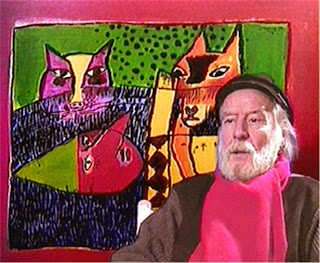.jpg) born in Belgium and died in France. He is buried on the same cemetery as Vincent van Gogh, a painter he highly admired .
born in Belgium and died in France. He is buried on the same cemetery as Vincent van Gogh, a painter he highly admired . What to do?
Show examples of Corneille's work. What subjects do you often see in his paintings? What do you notice about his style? Discuss the features: bright colours, thick black outlines, few details, painted as if it was made by a child, an image that sometimes is not complete (missing parts at the edges).
zaterdag 12 juni 2010
Liquorice Allsorts
Made by Malou, 11 years old
You need:
- Liquorice Allsorts
- grey construction paper A3 size
- oil pastels
Liquorice allsorts consist of a variety of liquorice candies sold as a mixture. These confections are made of liquorice, sugar, coconut, aniseed jelly, fruit flavourings, and gelatine. They were first produced in Sheffield, England. Allsorts are produced by many companies around the world today, and are most popular in Britain, continental Europe, and North America. The Dutch name for liquorice allsorts is "Engelse drop", and in Finland they are called "Englannin lakritsi/laku"; both literally translate as "English liquorice."
Make groups of two children. Buy some bags of liquorice allsorts (I used one bag for six students). Divide the liquorice so so that each group can make a different composition of them.
Give the children a sheet of grey construction paper. I chose grey, because the oil pastels alle kinderen een grijs tekenvel. Grey, because the oil pastel colours will be slightly less bright, and the white of the liquorice allsorts will be clearly visible. Ask children to make a composition of the liquorice; they may be stacked also.
On the gray sheet students draw the liquorice extra large. The liquorice must really be blown up! Don't use pencils, draw directly with the oil pastel. The whole sheet have to be filled with liquorice allsorts, with parts of them on the edges of the sheet. Colour everything and look carefully to the light: which part of the liquorice has to be dark, and which part has to be coloured lighter? Vary in dark and light colours by pressing harder or softer.
And of course you may eat the liquorice after finishing your artwork!
Made by students of 10-11 years old
zondag 22 november 2009
Dutch December skyline
You need:
- construction paper A4 size in dark blue, yellow and black
- paperclips
- scissors
- knives
- cutting blade
- glue
Draw the skyline of a street on the black paper. Add a tree if you want to, or draw a black pete near the chimney.
Put the black sheet on the yellow one and attach them to each other with four paperclips. Cut out the skyline; you'll cut two sheets at the same time. When ready, remove the paperclips and cut some windows out of the black sheet.
Cut a moon out of the rest of the yellow sheet. Stick the black and yellow skyline together and shift the black sheet one millimeter to emerge the yellow one. Look carefully to the position of the moon: you'll see the yellow edges there were the moon shines. Glue the moon on the blue sheet and glue the skyline below. Your December skyline is finished!
dinsdag 15 september 2009
Delfts blue plates
- white paper plates without plastic coating
- feltpens, fineliners of markers in different colours blue
- examples from Delfts blue decoration
Delftware, or Delft pottery, denotes blue and white pottery made in and around the city of Delft (Netherlands) from the sixteenth to the eighteenth centuries. Delftware became popular and was widely exported in Europe and even reached China and Japan. Chinese and Japanese potters made porcelain versions of Delftware for export to Europe. Delftware ranged from simple household items - with little or no decoration - to fancy artwork. Most of the Delft factories made sets of jars, the kast-stel set. Pictorial plates were made in abundance, illustrated with religious motifs, native Dutch scenes with windmilles and fishing boats, hunting scenes, landscapes and seascapes.
Nowadays there is still one factory in Delft that produces real Delftware: De Porceleyne Fles. All plates, vases, bowls, teacups, tiles etc. are painted by hand here. You'll find a lot of photograps on the website of Porceleyne Fles (online shop). See some of these photographs with the students and discuss what decorations they see. Discuss the different colours of blue and look how you can make a good illustration by just using blue. Show the students some plates with different edges and make them tell about the recurring motifs
What to do? Students will design their own Delfts blue plate with a regular pattern around the plate and a free drawing in the middle. They have to use markers, feltpens and fineliners in different shades of blue. First practice a bit on the back side of the plate to see how the ink will flow. The edge of the plate has notches. Count them to know how many notches your pattern must have.
zaterdag 5 september 2009
Dutch canal houses
Made by Anne, 10 years old
You need:
- white drawing paper A4 size
- indian ink or fine black marker
- dip pen

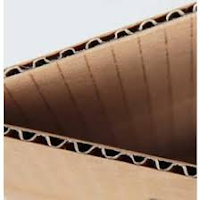






.jpg)
.jpg)
.jpg)




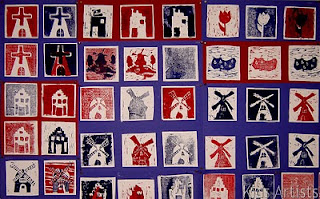
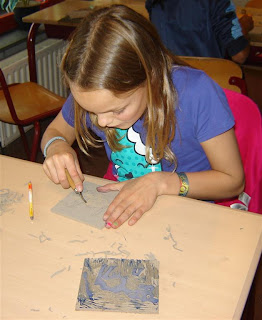
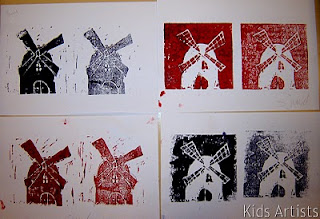
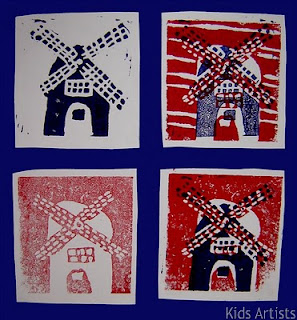

.jpg)
.jpg)
.jpg)
.jpg)

.jpg)
.jpg)
.jpg)
.jpg)








